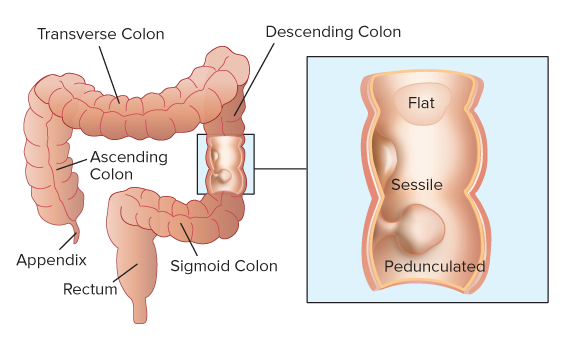
- 07914803818
- 02077940500 ext: 34273
- mvarcada.practice@nhs.net

Colonic polyps, also known as colorectal polyps, are growths that appear on the surface of the colon. The colon, or large intestine, is a long hollow tube at the bottom of the digestive tract. It’s where the body makes and stores stool.
Polyps in the colon can vary in size and number. There are three types of colon polyps:
Hyperplastic polyps are harmless and do not develop into cancer.
Adenomatous polyps are the most common. Although most will never develop into cancer, they do have the potential to develop into colon cancer.
Malignant polyps are polyps that are noted under microscopic examination to have cancer cells in them.
In most cases, polyps do not cause symptoms and are usually found on routine colon cancer screening exams. However, if you do experience symptoms, they may include:
blood in the stool or rectal bleeding
pain, diarrhea, or constipation that lasts longer than one week
nausea or vomiting if you have a large polyp
Blood on your toilet tissue or blood streaked stools may be an indication of rectal bleeding and should be evaluated by a doctor.

It's important to have regular screening tests to detect any existing polyps. When colonic polyps are found in the early stages, they can often be removed safely and completely during a colonoscopy. Removing polyps may reduce your risk of developing colon cancer.
Doctors don’t know the exact cause of colonic polyps, but polyps result from abnormal tissue growth. The body periodically develops new healthy cells to replace old cells that are damaged or no longer needed. The growth and division of new cells is usually regulated. In some cases, however, new cells grow and divide before they’re needed. This excess growth causes polyps to form. The polyps can develop in any area of the colon.
Colonoscopy: During this procedure, a camera attached to a thin, flexible tube is threaded through the anus. This allows your doctor to view the rectum and colon. If a polyp is found, your doctor can remove it immediately or take tissue samples for analysis.
Sigmoidoscopy: This screening method is similar to a colonoscopy, but it can only be used to see the rectum and lower colon. It can’t be used to take a biopsy, or a sample of tissue. If your doctor detects a polyp, you'll need to schedule a colonoscopy to have it removed.
Barium enema: For this test, your doctor injects liquid barium into your rectum and then uses a special X-ray to take images of your colon. Barium makes your colon appear white in the pictures. Since polyps are dark, they’re easy to identify against the white color.
CT colonography: This procedure uses a CT scan to construct images of the colon and rectum. After the scan, a computer combines the images of the colon and rectum to produce both 2- and 3-D views of the area. A CT colonography is sometimes called a virtual colonoscopy. It can show swollen tissues, masses, ulcers, and polyps.
Stool test: Your doctor will give you a test kit and instructions for providing a stool sample. You’ll return the sample to your doctor’s office for analysis, especially to test for microscopic bleeding. This test will show if you have blood in your stool, which can be a sign of a polyp.
The best way to treat colonic polyps is to remove them. Your doctor will likely remove your polyps during a colonoscopy. The polyps are then examined under the microscope to see what type of polyp it is and if there are any cancer cells present. Doctors can usually get rid of polyps without performing surgery.
However, you may need surgery to remove the polyps if they’re large and can’t be removed during a colonoscopy. In most cases, this can be done by laparoscopic surgery. This type of surgery is minimally invasive and uses an instrument called a laparoscope. A laparoscope is a long, thin tube with a high-intensity light and a high-resolution camera at the front. The instrument is inserted through an incision in the abdomen. Once your surgeon has a visual of your colon, they’ll remove the polyps using a special tool.
A pathologist, or someone who specializes in tissue analysis, will check the polyps for cancerous cells.
Adenoma is a type of non-cancerous tumor or benign that may affect various organs. It is derived from the word “adeno” meaning 'pertaining to a gland'.
Every cell in the body has a tightly regulated system that dictates when it needs to grow, mature and eventually die off. Tumors and cancers occur when cells lose this control and divide and proliferate indiscriminately.
The basic difference between a benign tumor and a cancer is its slower growth and lower capacity to spread. In other words adenomas are much less aggressive in terms of growth than adenocarcinomas.
Adenomas may affect various organs including Colon, Pituitary gland, Thyroid gland, Breasts, Adrenal gland and Kidneys.
Colons are the most common organs that are affected by adenomas. There may be detected on colonoscopy. A regular surveillance of colonic adenomas and preferable removal of these tumors is advised as they have a very high potential to become colon cancers.